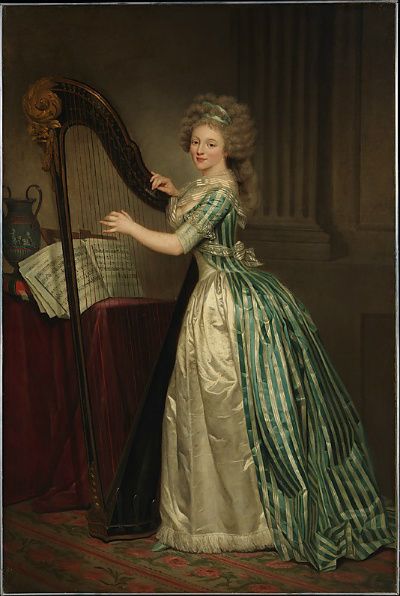Part 2
Part 3

Self Portrait with a Harp, by Rose Adélaïde Ducreux, c. 1791. In the collection of The Metropolitan Museum of Art.
Between the soft curves abounding in her portrait and the display of musical talent on the harp, Ducreux sends a strong message of her femininity, an important point to note in both the context of the art world and France at large. Painting had traditionally been a male profession, with women artists taking up an extremely small percentage. In 1770, the Royal Académie, which had never welcomed more than a handful of female artists into its membership, placed a quota for four female members. However, women increasingly made an effort to put their works on display, and at the Salon of 1791, twenty two women exhibited their works. While women artists were making great strides towards recognition, they remained the minority. Pierre-Jean-Baptiste Chaussard was alarmed at the 1806 Paris Salon to note that out of 350 artists, fifty were women.
In a broader context, these negative reactions towards women artists reflect the strong reinforcement of gender roles which took place at the end of the eighteenth century. The cult of motherhood became a particular concern, with writers and artists urging women not to pass their children off to a nurse but to rear them personally. Motherhood was espoused as the natural state for women, and, as one writer said, “The sensations experienced by a woman when she becomes a mother are of a kind superior to anything she feels in other circumstances.” This attempt to relegate women to the roles of mothers and nothing else is indicative of this larger trend of strongly defined gender roles. With society being completely restructured in the Age of Revolution, perhaps these strict definitions were a way of clinging to a sense of natural order.
As a female artist, Ducreux inhabited a traditionally male occupation. Although the fine arts were seen as a relatively natural outlet for women, due to their delicate sensibilities, a participation in the fine arts was none the less a step outside the home. Ducreux counters concern about women straying into a male world by emphasizing her femininity in her painting. The soft curves and the demonstrated accomplishment on the harp all signify Ducreux as an accomplished woman, showing off her feminine attributes. Her less radical clothing choice further symbolizes her devotion to traditional femininity. The soft and supple textiles and traditional style of dress portray Ducreux as a woman being a woman, not a woman attempting to enter the male world of personal autonomy and power as Marie Antoinette did.